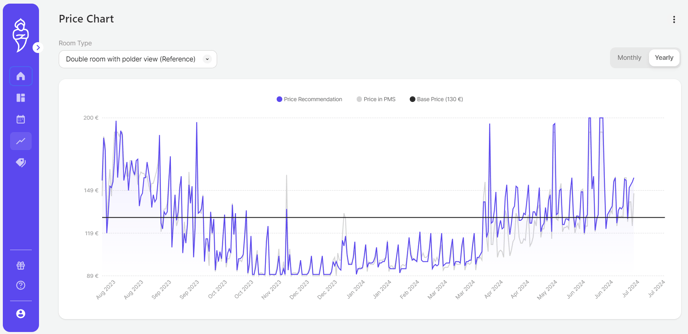Weekly and Monthly Adjustments
The article explains the process of carrying out Weekly and Monthly Adjustments in RoomPriceGenie.
| Product Plan |
|---|
| Advanced |
| Professional* |
*This feature is available in both Advanced and Professional plans, with additional advanced options to the Professional plan.
Day-of-the-Week Adjustments
The Day-of-the-Week Adjustments can help you identify days of the week when you need to be more or less expensive than the hotels your Market Intelligence represents.
Example: Leisure hotels tend to need adjustments to decrease prices on weekdays compared to business hotels. They will also need adjustments to increase prices on Fridays and Saturdays.
Monthly Adjustments
The Monthly Adjustments can help you identify and adjust months of the year when you need to be more or less expensive than the hotels represented by your Market Intelligence. They are also used to represent seasonality.
Example: While business hotels are quieter in summer, leisure hotels do comparatively better. Thus, an upward monthly adjustment in summer is standard for leisure hotels in an area of business hotels.


🟠 Level of Local Market
We are checking the rates of other properties that represent the property's local 'market'. Next, we estimate what they would charge if they had the same base price as the hotel.
🟣 Average Base Price
The base price (blue) follows the local market (red). These numbers represent the base price defined in the Rooms Setup plus the Market factor.
The grey column shows the "end result" of all adjustments, meaning the Base Price plus the Market plus the Occupancy / Pick-up factor.
⬜ Average Base Price Next 3 Months/Base Price for the Month
These numbers show each month's average base price plus the average market factor increase/decrease. That way, we visualize the seasonality, and you may apply a manual monthly adjustment to refine your strategy.
⬜ Adjust Price by
Adding adjustments here will impact the day of the week/monthly price. You can adjust the day of the week or monthly price start point based on the average market forecast and your property's historical trends. Use the 'Price in PMS' as a reference but not as an unconditional truth.
Why and When should I use the Day-of-the-Week and Monthly Adjustments in RoomPriceGenie?
When we initially set up your hotel, we will often input these adjustments. So, do not be surprised to see numbers you did not set.
As a quick recap, we analyse your whole market and identify hotels with a sophisticated approach to Revenue Management. Your hotel may have different characteristics compared to the hotels that we choose to represent your Market Intelligence.
NOTE: When we set up your property, we often input these adjustments on your behalf.
You might not need to change these settings unless you still find big differences in demand for different weekdays/months. Regarding day-of-the-week adjustments, this could be because your business-leisure mix has changed over time.
Day-of-the-Week Adjustments Example: You may be busier on Sundays because you have an amazing restaurant that attracts more guests compared to Sundays at other hotels. In this case, you may choose to price higher on this day as you know that the demand for your hotel is stronger. Using ‘Day-of-the-Week Adjustments’ shall help us accomplish that.
Regarding monthly adjustments, the first thing to point out is that we automatically change your monthly pricing with demand for the whole month, so we will usually be on top of this for you. But if you need to make further adjustments, this is a good broad seasonal adjustment.
Monthly Adjustments Example: February is a month with school holidays in Switzerland that can be very good for a property with Family rooms and kids' amenities. Therefore, this property can have a higher price for the month of February as that is the month when families travel. Using ‘Monthly Adjustments’ shall help us accomplish that.
Manage Day of the Week & Monthly Adjustments
- The 'Day of the week adjustments' can be better understood using the following tutorial:
(We are currently updating our knowledge base to the new UI. Thank you for your understanding if you still see an outdated display. Nonetheless, the step-by-step guide will remain the same.)
- The 'Monthly adjustments' can be better understood using the following tutorial:
(We are currently updating our knowledge base to the new UI. Thank you for your understanding if you still see an outdated display. Nonetheless, the step-by-step guide will remain the same.)
